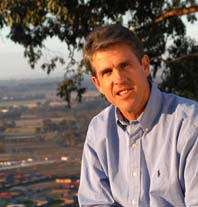A Charles Sturt University (CSU) professor has cautioned that accepting without question what he has described as “some pervasive beliefs about rural Australia related to farming and land management” could lead to poor planning of Australia’s agricultural future.
 “There is this really strong view in Australia that there is a global food crisis and a rising middle class in Asia and that the two of these combined will somehow ‘lift’ the futures of Australian agriculture -that all we have to do is sit back and wait,” said Professor Allan Curtis, a social researcher with CSU’s Institute for Land, Water and Society.
“There is this really strong view in Australia that there is a global food crisis and a rising middle class in Asia and that the two of these combined will somehow ‘lift’ the futures of Australian agriculture -that all we have to do is sit back and wait,” said Professor Allan Curtis, a social researcher with CSU’s Institute for Land, Water and Society. “I think these are beliefs that need to be tested and I’m not sure that anyone is critically examining them.” Professor Curtis is the after-dinner speaker at the Real Estate Institute of Victoria’s annual conference in Bendigo on Tuesday evening, 3 July.
He said that while he personally believed there were lots of hungry people in the world, that we could have a food crisis, and that the emergence of wealthy Asians was an opportunity for Australian agriculture, none of these were certainties.
“Often hunger is not to do with lack of food, it’s to do with poor governance, for example, wars, governments keeping food prices down to prevent unrest which discourages farmers from producing food, and transport failures,” he said.
He has noted plenty of examples of where more food could be produced or the food produced could be used more wisely.
“Good examples of that are the amount of fish we feed to cats; the ironic situation of cut-flowers being sent from Africa to Europe at a time when Europe was sending food aid to Africa; and the farmland I’ve seen abandoned or underutilised on my travels overseas,” Professor Curtis said.
“The land was abandoned because farmers can earn more working in cities and we are not talking about much – in India if a farmer can earn more than $2 per day in the city he may leave the farm. Surely, if there was a world-wide shortage of food the price of food would be higher.”
He said if there was a global food crisis there were two reasons why Australia would not be able to solve it.
“One, we don’t produce enough food to make that much difference and two, our food is too expensive for poor people to buy, which is also why Australia may not benefit from increased food demand.
“Many other countries want to supply food, which they can do at a fraction of the cost that food can be produced in Australia. There is new farmland being opened up in South America and Africa, there is abandoned land in Europe and India which could be used.”
Professor Curtis also questioned whether Australia can benefit from demand for food among the rising Asian middle class.
“I don’t think the middle class in Asia are as wealthy as people in Australia think they are – in India a middle class income is one tenth of what it is in Australia, and culturally most Indians have a preference for local foods,” he said.
”I think wealthy people in India and China are more likely to be our potential market but we have to make sure we meet their requirements and produce things they want, but it is likely that others might produce those things cheaper. I don’t think being ‘clean and green’ will be enough.”
As it is, the livelihoods of Australian farmers are being threatened by competition from overseas.
“What agricultural product has gone up beyond the rate of inflation over the last five years and stayed there? In fact I’m hearing from farmers all the time about the poor returns they get and the competition they face from overseas lower-cost producers who can access our markets cheaply.”
Professor Curtis said Australia could increase its food production from dryland areas that are largely underused, in part because of competition from irrigated agriculture. He thought we could also increase food production from irrigated agriculture if there was real demand for high value products.
“About 40 per cent of water for irrigated agriculture in the Murray-Darling Basin goes on grass, largely because there are no markets for any other product,” he said.





Social
Explore the world of social